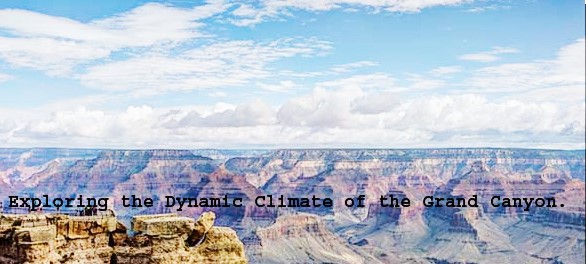
Introduction
The Grand Canyon, a geological marvel carved by the mighty Colorado River, stands as a testament to the Earth’s intricate history. Beyond its breathtaking landscapes and awe-inspiring vistas, the Grand Canyon is also known for its diverse and sometimes unpredictable weather patterns.
Exploring this natural wonder requires an understanding of the ever-changing Grand Canyon weather, as it can greatly influence the visitor experience. In this comprehensive guide, we will delve into the intricacies of the Grand Canyon’s climate, seasonal variations, and the impact of weather on the overall adventure.
Geographical Factors Influencing Grand Canyon Weather
Before delving into the specifics of Grand Canyon weather, it is essential to understand the geographical factors that contribute to its climate. The Grand Canyon, located in northern Arizona, spans over 275 miles and reaches depths of more than a mile. The canyon’s vastness creates distinct temperature and weather variations based on its elevation and the North and South Rims’ geographical differences.
Elevation Gradient:
- The Grand Canyon features a significant elevation gradient from the North Rim to the South Rim. The North Rim, situated at a higher elevation, generally experiences cooler temperatures than the South Rim. This elevation difference contributes to variations in weather conditions between the two rims.
Colorado River Influence:
- The Colorado River, carving its way through the canyon, also plays a crucial role in shaping the local climate. The river’s presence contributes to temperature moderation, creating milder conditions in the inner canyon compared to the rims. Additionally, the river’s flow can impact humidity levels and influence weather patterns.
Seasonal Variations in Grand Canyon Weather
Understanding the seasonal changes is vital for planning a visit to the Grand Canyon, as each season offers a unique experience shaped by distinct weather patterns.
Spring (March to May):
- Spring brings a sense of renewal to the Grand Canyon, with blooming wildflowers and milder temperatures. Daytime temperatures on the rims range from 50 to 70 degrees Fahrenheit, making it an ideal time for hiking and outdoor activities. However, it’s essential to be prepared for occasional rain showers, and visitors should be cautious of rapidly changing weather conditions.
Summer (June to August):
- Summer at the Grand Canyon is characterized by warmer temperatures, especially in the inner canyon. Daytime temperatures on the rims can exceed 90 degrees Fahrenheit, while temperatures in the inner canyon may soar above 100 degrees. Visitors should take precautions to stay hydrated and avoid strenuous activities during the hottest parts of the day. Thunderstorms are common in the afternoons, bringing lightning and sudden rain, which can lead to flash floods.
Fall (September to November):
- Fall offers pleasant temperatures and striking landscapes as the foliage changes color. Daytime temperatures on the rims range from 50 to 70 degrees Fahrenheit, making it an excellent time for outdoor activities. While fall is generally drier than summer, occasional rain and cooler evenings are possible. Visitors should be prepared for temperature variations and potential rain showers.
Winter (December to February):
- Winter at the Grand Canyon brings cooler temperatures and occasional snowfall, especially on the rims. Daytime temperatures on the rims can range from 20 to 40 degrees Fahrenheit, while temperatures in the inner canyon remain milder. Winter conditions can make hiking and other outdoor activities more challenging, and visitors should be prepared for snow and icy trails. The South Rim, being more accessible during winter, offers a quieter and serene experience.
Microclimates within the Grand Canyon
The Grand Canyon’s vast expanse creates microclimates, leading to temperature and weather variations within short distances. Understanding these microclimates is crucial for visitors seeking a more tailored experience.
Inner Canyon:
- The inner canyon, where the Colorado River flows, experiences warmer temperatures compared to the rims. During the summer, temperatures can exceed 100 degrees Fahrenheit, creating a stark contrast to the cooler conditions on the rims. Hiking in the inner canyon requires careful planning, especially during the hottest parts of the day.
North Rim vs. South Rim:
- The North Rim, at a higher elevation, generally experiences cooler temperatures than the South Rim. The North Rim’s elevation contributes to a shorter season, with the park typically closing during the winter months due to heavy snowfall. Visitors should consider these differences when planning their Grand Canyon adventure.
Weather Hazards and Safety Considerations
While the Grand Canyon’s weather offers a diverse range of experiences, it is essential for visitors to be aware of potential hazards and prioritize safety. Some key considerations include:
Flash Floods:
- The arid climate of the Grand Canyon can lead to sudden, intense rainfall, resulting in flash floods. These floods can occur with little warning, especially during the summer monsoon season. Hikers should be cautious of weather forecasts and avoid narrow canyons during stormy weather.
Extreme Temperatures:
- The Grand Canyon experiences a wide range of temperatures, from scorching heat in the inner canyon during summer to freezing conditions on the rims in winter. Visitors should dress in layers, stay hydrated, and be aware of their physical limitations, especially when engaging in strenuous activities.
Thunderstorms and Lightning:
- Summer afternoons often bring thunderstorms to the Grand Canyon. Lightning poses a significant risk, especially in exposed areas. Hikers should plan their activities accordingly, avoiding high-risk areas during stormy weather.
Winter Conditions:
- Winter at the Grand Canyon brings snow and icy conditions, particularly on the rims. Visitors should be prepared for cold temperatures, dress appropriately, and be cautious of slippery trails. Road closures may occur during heavy snowfall, affecting access to certain areas.
Preparing for a Grand Canyon Visit
To make the most of a visit to the Grand Canyon, it is essential to be well-prepared for the dynamic weather conditions. Here are some tips to ensure a safe and enjoyable experience:
Check Weather Forecasts:
- Before embarking on a Grand Canyon weather adventure, check weather forecasts for both the rims and the inner canyon. Be aware of any potential changes in weather conditions and plan activities accordingly.
Dress in Layers:
- The Grand Canyon’s temperature variations require visitors to dress in layers. This allows for adjustments based on changing conditions, ensuring comfort throughout the day.
Stay Hydrated:
- Regardless of the season, staying hydrated is crucial, especially during the warmer months. Carry an adequate supply of water, and be mindful of water sources in the inner canyon.
Plan Outdoor Activities Wisely:
- Plan outdoor activities, especially hikes, with consideration for weather conditions. Be aware of potential hazards such as flash floods, extreme temperatures, and lightning storms. Inform someone of your plans, and always carry essential gear, including maps and a first aid kit.
Be Flexible:
- Grand Canyon weather can be unpredictable. Be prepared to adapt your all plans based on changing conditions. This flexibility ensures a safer and more enjoyable experience.
Conclusion
The Grand Canyon’s weather adds a layer of complexity to the already mesmerizing landscape, creating a dynamic and ever-changing environment. Visitors to this natural wonder must be prepared for the diverse conditions they may encounter, from scorching summer heat to winter snowfall. Understanding the seasonal variations, microclimates, and potential hazards is essential for a safe and fulfilling Grand Canyon experience. By embracing the nuances of the canyon










Thank you for your sharing. I am worried that I lack creative ideas. It is your article that makes me full of hope. Thank you. But, I have a question, can you help me?